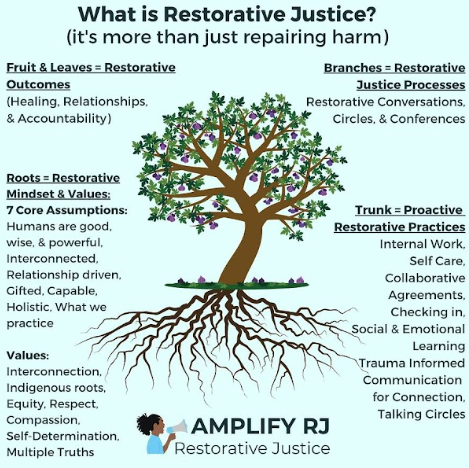Bijan Heydari is Arvada West High School’s Restorative Justice Counselor. Heydari’s job at A-West is to help students, teachers, and staff with conflict between each other. Heydari works closely with the deans to decide what disciplinary measures are needed to be taken with students. He states that if a student gets into a fight or other conflict, that student might get suspended for a few days as a consequence but, Heydari explains that a suspension might not result in behavior change, which then will continue the cycle of violence.
According to Heydari, “Restorative practices argue that that doesn’t lead to any change in behaviors. So when someone goes home for a few days, it leads to isolation, then leads to more shame within people, and actually, isolation and shame are two of the leading causes of violence. So it makes it more likely that they’re going to be violent when they come back.” Heydari points out that it can be difficult for individuals to look beyond the harm that someone has caused and identify the underlying reasons for their behavior. This could include issues at home or past traumas that have left the person hurting. He quotes the phrase “hurt people hurt people” and says someone who has been harmed, can find it challenging to understand why someone would hurt others in the same way.
In such situations, a conference is organized with the individuals who have been harmed, along with their chosen support people such as a friend, teacher, or any other person they wish to bring along. During the conference, the group discusses what happened and the impact it had on the affected parties. Heydari mentions that these conferences revolve around four key questions: What happened, who was affected and how, what part can you take responsibility for, and how can the harm be repaired?
“The repairing of harm is probably the funnest part of this job because you just get creative, you hear creative answers from students. Just allows them to think outside the box like ‘hey, if I did something bad, I can do good to repair the bad I did and I’ll feel good about myself too, and the other person will feel good,’ it’s gonna bring connection, rather than what punishment does is bring separation,” stated Heydari.

Heydari explains restorative justice as a tree, the roots as values, and the trunk as before harm had been done. These are called proactive restorative practices such as eternal work, self-care, meditation, and anything that brings mindfulness. The branches are the process of restorative justice, which is when they have a conversation and bring the people who were harmed and did the harm together. Then the fruits on the tree are what come out of it such as restoration with one’s self, and healthier relationships.
Some may wonder what makes Heydari different from a normal counselor. The main difference is that when people think of a counselor they might imagine someone who primarily deals with mental health issues such as depression and anxiety. Counselors also spend a lot of time making schedules and acting as the first line of support when students need someone to talk to. Heydari, on the other hand, is more focused on resolving conflicts between students and there is often a mental health component to conflicts, so students who come to a counselor seeking conflict resolution are referred to Heydari.
Heydari states that he has always been “fueled by conflicts in terms of, how can we find healthier ways to navigate conflicts.” Heydari went to school for conflict resolution and found restorative justice through that. He mentions that he thinks the hardest part of his job is getting people to move away from the eye-for-eye mentality. He states that if someone does something wrong, and someone gets hurt, they feel they should do the same thing back which then continues the circle of violence. He also mentions that it is hard for people to see beyond the harm to see what had caused the behavior and mentions that people often fail to look beyond the harmful behavior to understand its root cause.
Heydari went to school for four years before he moved on to grad school which was a two-year program for conflict management and resolution. He went to the University of San Diego, and got to work with their Center for Restorative Justice and worked with cases where there might have been harm on campus. Heydari had also gotten a certificate in wellness coaching which is where the Wellness Coach helps someone achieve their wellness goals, which are set around physical and emotional health, he had done wellness coaching for a while and had been trained at Duke University in North Carolina.
Heydari says that his favorite part of his job is the repairing of harm and hearing creative answers from students and how it allows them to think outside the box to fix the conflict.



